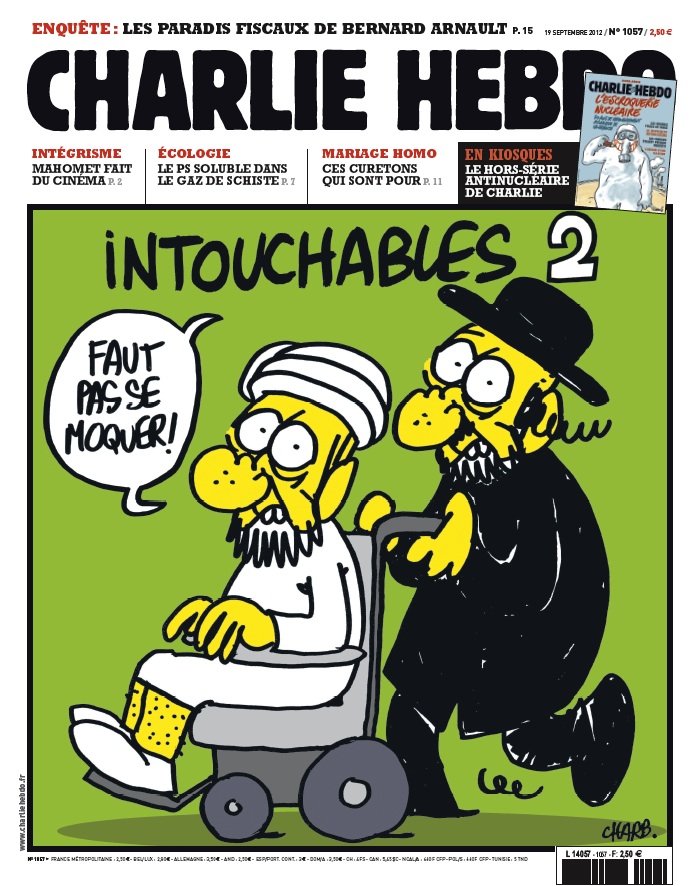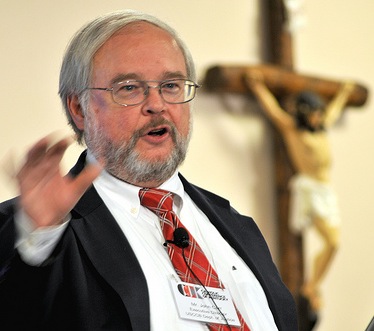Get ready GetReligion readers for the next twist in the Muslim outrage story. Today’s issue of Charlie Hebdo — a lowbrow political humor magazine akin to Private Eye — tops the “Innocence of Muslims” film in crassness and bad taste.
That direct to YouTube video produced by an expatriate Egyptian Copt denigrates Islam and Muhammad, denouncing him as a charlatan, womanizer, and sexual degenerate. The rest is history.
While some members of the mob that assaulted the U.S. embassy may have been paid to express their outrage, and it is unlikely the well planned assault on the consulate in Benghazi that led to the rape and murder of the U.S. ambassador was an act of spontaneous outrage — there is little doubt the film has sparked indignation across the Muslim world.
And at this point in the story, Charlie Hebdo steps in. The cover of the offending issue portrays an Orthodox Jew pushing a Muslim in a wheelchair. Atop the cartoon is the mock-movie title “Untouchables 2”, which Reuters says is:
a reference to a hugely popular French movie about a paralyzed rich white man and his black assistant.
The text balloon states “You must not mock”, but there is also the undertone of “Make my day” here also. Last November the offices of Charlie Hebdo were firebombed after they put Muhammad on the cover of their magazine and ran some distasteful cartoons inside the magazine.
It may be worse this time round. France 24 reported that after today’s issue of the magazine was released, the Quai d’Orsay announced it was closing 20 French embassies on Friday in anticipation of trouble. Foreign Minister Laurent Fabius, who happens to be in Cairo today, expressed his anger at the timing of the release of these new cartoons. Publishing inflammatory cartoons while the Muslim world was still seething over the YouTube video was not helpful to the cause of peace, he told i-Télé. However, Prime Minister Jean-Marc Ayrault has affirmed that freedom of speech is a fundamental principle for France.
The anger at Charlie Hebdo will focus on the cartoons on the inside of the magazine, not the cover. Here is a link to one page where you can see for yourself what is causing the fuss. Taking its film theme from the Youtube video, Charlie Hebdo portrays Muhammad as a gay porn star.
I suspect we will see calls for censorship of Charlie Hebdo just as the “Innocence of Muslims” has prompted pro-censorship commentaries in the U.S. press. Some self-censorship around the Charlie Hebdo story has already begun. While some European and American newspapers and broadcasters have not held back on showing the cover, Fox News, ABC News, CBS News, the Guardian, the Jerusalem Post, Al-Ahram and others chose to describe the cover and contents, but not show them to their readers. I’ve not seen any reprint the inside cartoons.
I too am guilty of self-censorship. I chose not to publish the risque cartoons on this blog, but placed them on a private page where a reader can examine them if he so chooses. Am I guilty of moral cowardice?
The editor of Charlie Hebdo spoke to RTL defended his decision to publish, saying:
If we start to ask questions now about whether or not we have the right to draw Muhammad, if it’s dangerous or not, the next questions is going to be: ‘Can we show images of Muslims in the paper?’ Then the question after that will be: ‘Can we show images of people in the paper?’ And then at the end, we won’t be representing anything and this form of extremism that is happening around the world will have won.
Reuters quoted him as saying:
“To me, these religious hardliners who protest and kill over a crappy film are no different to the people who made the crappy film. They’re all the same pack, a bunch of assholes,” editor Stephane Charbonnier, under police protection since printing similar caricatures last November, told Reuters.
The last time Charlie Hebdo ran a Muhammad cartoon, I argued that this was done in bad taste and lacked journalistic merit — but it was their right to do so. I also stated that Islamic law does not forbid depictions of Muhammad. As my colleagues at GetReligion have pointed out in Everybody Draw Mohammad Day, South Park, and the Jyllands-Posten cartoons there is no one Muslim law, nor common view on this topic. Here is a gallery of Muhammad images in Western and Turkish art collections.
I also argued that the failure to print the Muhammad cartoon that prompted the firebombing of Charlie Hebdo, while printing covers from other issues of the magazine to illustrate the story, was moral cowardice. I rejected the contention that by publishing something that someone might find offensive you were crying fire in a crowded theater. I cited Christopher Hitchens in support of my argument. He wrote:
If you instigate something, it means that you wish and intend it to happen. If it’s a riot, then by instigating it, you have yourself fomented it. If it’s a murder, then by instigating it, you have yourself colluded in it. There is no other usage given for the word in any dictionary, with the possible exception of the word provoke, which does have a passive connotation. After all, there are people who argue that women who won’t wear the veil have “provoked” those who rape or disfigure them … It was bad enough during the original controversy, when most of the news media—and in the age of “the image” at that—refused to show the cartoons out of simple fear. But now the rot has gone a serious degree further into the fabric. Now we have to say that the mayhem we fear is also our fault, if not indeed our direct responsibility. This is the worst sort of masochism, and it involves inverting the honest meaning of our language as well as what might hitherto have been thought of as our concept of moral responsibility.
Tell me GetReligion readers, does this argument still work? Should we limit free speech in the name of a moral responsibility not to offend, or does the moral responsibility to act within the bounds of civilized society take precedence? Where I the editor of Charlie Hebdo I would not have commissioned the cartoons nor printed them in this climate. But having been printed, I believe the press should show them to their readers. I respect Charlie Hebdo‘s right to be offensive and crass, but would not do it myself. Is this moral cowardice? Preening or prudence? What say you?














